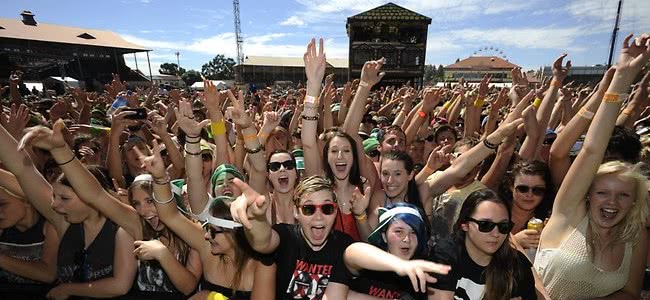The looming threat of a decaying live music scene in Australia has recently seen a boost in morale, with recent figures suggesting the industry has reversed its fortune and is now experiencing a much needed growth spurt.
Live music revenue has been gifted an increased support from music lovers nationwide, helping the industry increase its overall profitability and reigniting the besieged sector.
Following on from previous reports that the latest findings from the Ticket Attendance & Revenue Survey, conducted by Live Performance Australia, demonstrating that the Australian live performance sector turned over $1.3 billion last year, with music making up $539 million of that figure.
Australians have once again verified their lust for live music entertainment, with The Music Network reporting that punters have contributed an 8.6% growth to the industry from a 2011 report, where the Australian Live Music market was valued at $635 million.
According to the forecast bv PriceWaterhouseCooper’s annual entertainment report, Media Outlook 2012-2016, the industry can also look forward to a 5.5% yearly average increase, hitting a top of $830 million within the next five years.
The increase in attention is being brought on by the strong Australian dollar, which is contributing to an increase in international acts waging their fortunes on Australian shores. International performers are seeking the high-end ticket prices, which are becoming popular luxury items for Australian music enthusiasts.
PriceWaterhousCooper executive Megan Brownlow contended that Australia’s economy was a the key to “luring bigger acts and paying them more money, attracting high-end ticket pricing.” Adding that the increase in new live venue locations was another factor driving the market – especially the older crowd. Noting there’s been “some clever market segmentation, that recognises the older consumer, the 35-plus set.”
“We have seen promoters getting very smart on new locations for live entertainment. Innovating with concerts at vineyards or less traditional live venues like Taronga Zoo are producing good growth results in that market,” said Brownlow.
The live music industry has a backlist of sub-industries to thank for the recent spike in revenue. At the top of this list, surprisingly, is the recent uprising of online streaming mediums such as Spotify, Deezer and Tunecore, to name a few. These services allow customers to stream tracks on end for a monthly subscription fee, rather than purchasing (or ‘borrowing‘) a digital copy of the track.
While the digital consumption of music on streaming services may not be majorly profitable for lesser known acts (each stream attracting 0.3 cents for the owner), the service provides a great platform for artist exposure; an invaluable feature for acts looking to attract consumer attention.
So much so, that record sales alone are no longer the sole quantifier of a band or artist’s success, “The industry needs to learn the lesson of valuing the artist-fan relationship as highly as you would traditional rights,” says Brownlow.
According to the report, the digital revolution will have a significant effect on the music industry’s global revenue over the next five years, in a slow but steady growth. Pushing global takings to an estimated $24.5 billion by 2016, the report claims. A shift that means a boon to the industry, but could also force a survival of the fittest situation on artists.
“Psychologically that will be a huge fillip in the recorded industry,” says Brownlow. “Essentially as an industry it will have been re-priced and those that can survive that new playing field will re-emerge – those that can’t won’t.”
Although physical music sales are still overshadowing its digital counterpart (63.3% of total sales compared to 34%), digital services are providing consumers with quick and easy access to content without having to leave the house.
Despite the increase of digital music sales however, PriceWaterhouseCooper’s report anticipates that the gap between the two will decrease, looking to balance out within the next two years.
Their findings suggest that while fans are more than happy to consume the digital products with practicality in mind, rather than opting to search through stores to find physical CDs and Vinyl, just as many are willing to go the distance to purchase the physical product.
A move that’s reflected in Australians paying the necessary cost for the enhanced live experience, as the addition of new venues and the older market is warmly welcomed by both fans and performers, who have now been recognised as a major fabricator and economic contributor.
“Australians are early digital adopters,” says Brownlow. “So we will get a sense very early on as to who is hitting the mark. All the international players in our market will want indicators within 12 months, so by this time next year we will have a very clear idea of who stands or falls.”
One unexpected focal point of the live music growth in Australia is the recent decline in music festival profitability. Attendance experienced a drop, falling by 4.2%, across even the largest Australian festivals like Splendour In The Grass, Future Music and the Big Day Out.
Live Performance Australia Chief executive Evelyn Richardson commented on the figures, saying “Ticket pricing is a very subjective thing… appropriate pricing naturally varies from act to act,” said Richardson.
Adding that: “Our research does suggest that consumers are prepared to pay premium prices for once in a lifetime experiences. There are certain acts that people just don’t want to miss.”
One thing is for certain; Australian music lovers will never be able to resist the thrill and ecstasy of experiencing their music idols in favour of digital mediums.

































